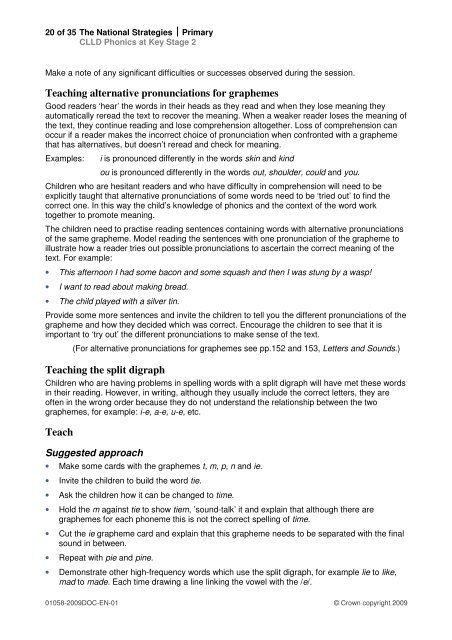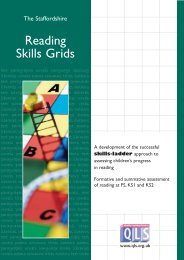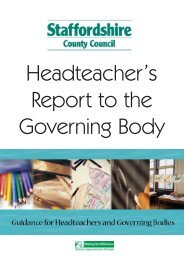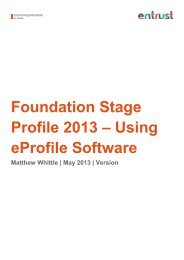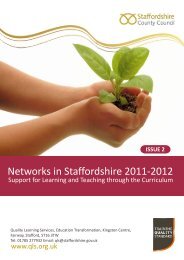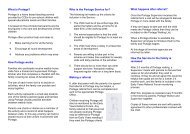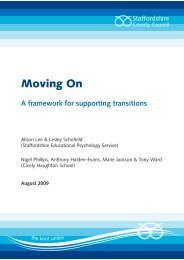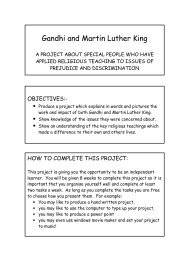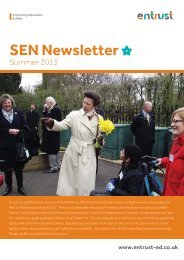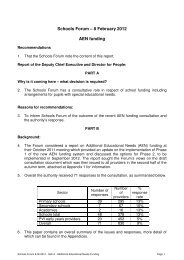CLLD Phonics at Key Stage 2 - School-Portal.co.uk
CLLD Phonics at Key Stage 2 - School-Portal.co.uk
CLLD Phonics at Key Stage 2 - School-Portal.co.uk
You also want an ePaper? Increase the reach of your titles
YUMPU automatically turns print PDFs into web optimized ePapers that Google loves.
20 of 35 The N<strong>at</strong>ional Str<strong>at</strong>egies ⏐ Primary<br />
<strong>CLLD</strong> <strong>Phonics</strong> <strong>at</strong> <strong>Key</strong> <strong>Stage</strong> 2<br />
Make a note of any significant difficulties or successes observed during the session.<br />
Teaching altern<strong>at</strong>ive pronunci<strong>at</strong>ions for graphemes<br />
Good readers ‘hear’ the words in their heads as they read and when they lose meaning they<br />
autom<strong>at</strong>ically reread the text to re<strong>co</strong>ver the meaning. When a weaker reader loses the meaning of<br />
the text, they <strong>co</strong>ntinue reading and lose <strong>co</strong>mprehension altogether. Loss of <strong>co</strong>mprehension can<br />
occur if a reader makes the in<strong>co</strong>rrect choice of pronunci<strong>at</strong>ion when <strong>co</strong>nfronted with a grapheme<br />
th<strong>at</strong> has altern<strong>at</strong>ives, but doesn’t reread and check for meaning.<br />
Examples: i is pronounced differently in the words skin and kind<br />
ou is pronounced differently in the words out, shoulder, <strong>co</strong>uld and you.<br />
Children who are hesitant readers and who have difficulty in <strong>co</strong>mprehension will need to be<br />
explicitly taught th<strong>at</strong> altern<strong>at</strong>ive pronunci<strong>at</strong>ions of some words need to be ‘tried out’ to find the<br />
<strong>co</strong>rrect one. In this way the child’s knowledge of phonics and the <strong>co</strong>ntext of the word work<br />
together to promote meaning.<br />
The children need to practise reading sentences <strong>co</strong>ntaining words with altern<strong>at</strong>ive pronunci<strong>at</strong>ions<br />
of the same grapheme. Model reading the sentences with one pronunci<strong>at</strong>ion of the grapheme to<br />
illustr<strong>at</strong>e how a reader tries out possible pronunci<strong>at</strong>ions to ascertain the <strong>co</strong>rrect meaning of the<br />
text. For example:<br />
• This afternoon I had some ba<strong>co</strong>n and some squash and then I was stung by a wasp!<br />
• I want to read about making bread.<br />
• The child played with a silver tin.<br />
Provide some more sentences and invite the children to tell you the different pronunci<strong>at</strong>ions of the<br />
grapheme and how they decided which was <strong>co</strong>rrect. En<strong>co</strong>urage the children to see th<strong>at</strong> it is<br />
important to ‘try out’ the different pronunci<strong>at</strong>ions to make sense of the text.<br />
(For altern<strong>at</strong>ive pronunci<strong>at</strong>ions for graphemes see pp.152 and 153, Letters and Sounds.)<br />
Teaching the split digraph<br />
Children who are having problems in spelling words with a split digraph will have met these words<br />
in their reading. However, in writing, although they usually include the <strong>co</strong>rrect letters, they are<br />
often in the wrong order because they do not understand the rel<strong>at</strong>ionship between the two<br />
graphemes, for example: i-e, a-e, u-e, etc.<br />
Teach<br />
Suggested approach<br />
• Make some cards with the graphemes t, m, p, n and ie.<br />
• Invite the children to build the word tie.<br />
• Ask the children how it can be changed to time.<br />
• Hold the m against tie to show tiem, ’sound-talk’ it and explain th<strong>at</strong> although there are<br />
graphemes for each phoneme this is not the <strong>co</strong>rrect spelling of time.<br />
• Cut the ie grapheme card and explain th<strong>at</strong> this grapheme needs to be separ<strong>at</strong>ed with the final<br />
sound in between.<br />
• Repe<strong>at</strong> with pie and pine.<br />
• Demonstr<strong>at</strong>e other high-frequency words which use the split digraph, for example lie to like,<br />
mad to made. Each time drawing a line linking the vowel with the /e/.<br />
01058-2009DOC-EN-01 © Crown <strong>co</strong>pyright 2009


